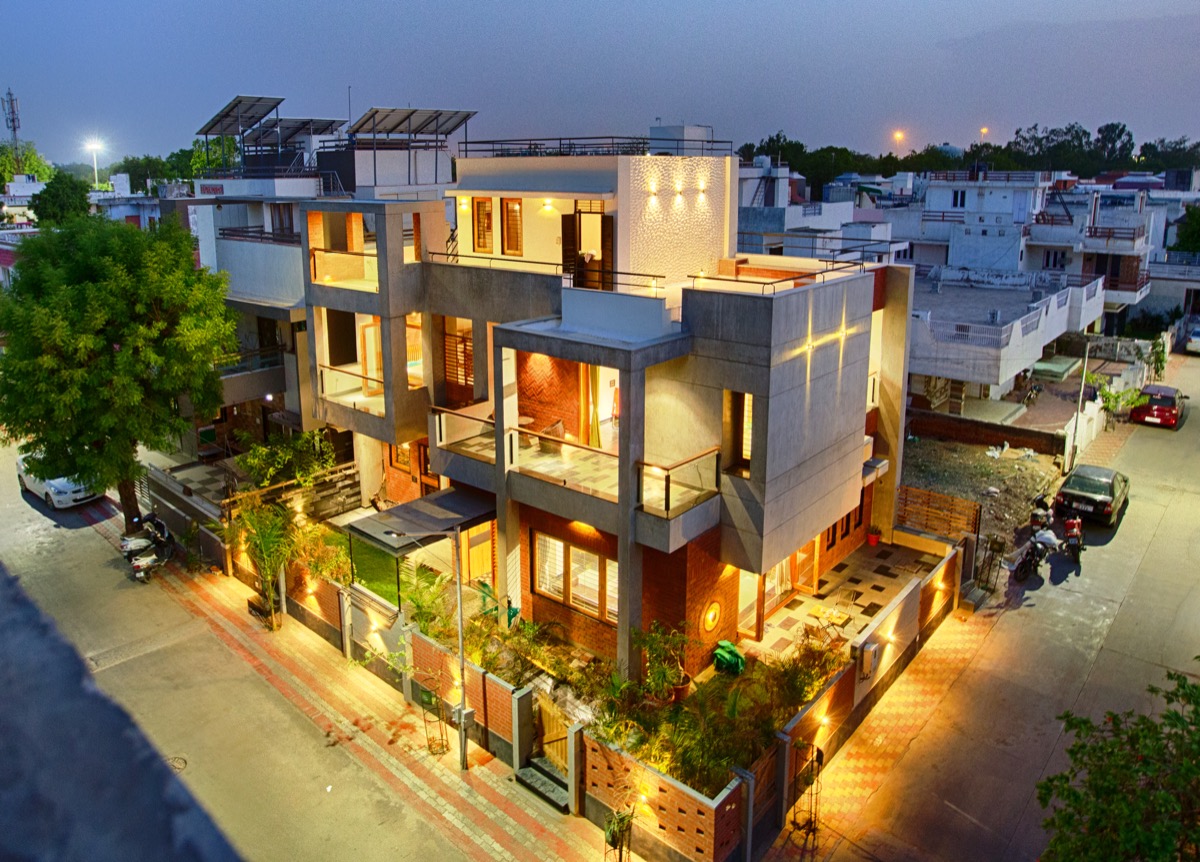Project Facts:
Project: Saraansh – House for Nitin Varsha
Client: Nitin, Varsha, & Sunny Vyas
Design Firm: URBSCAPES
Principal Architect: Narendra Mangwani, Nidhi Parikh
Design Assistance: Jay Bhanushali, Avni Kanani, Prabhuti Desai, Mansi Pitroda, Khushboo Anandpura.
Photography: Kartik Rathod, Prabhuti Desai, Khushboo Anandpura.
Status: Built (2014-2017)
Area : 4000 sq ft approx
Location: Ahmedabad, Gujarat
Building design: Ar. Krunal Panchal
Contractor & Engineer: Bhavin Panchal
Agencies: Rajubhai, Deepakbhai, Nareshbhai, Kesukaka, Kamleshbhai, Doodhnath, Devendrabhai, Motibhai.sukaka, Kamleshbhai, Doodhnath, Devendrabhai, Motibhai.
सारांश
House is a summary of one’s beliefs and values. So is Nitin Varsha House. Situated in the eastern part of Ahmedabad, the house sits on a square plot with two shared walls, allowing views to the corner opening. With road on two sides, the house open ups to allow light to the opposite corner. The clients wanted a modern house with natural finishes. Local stone, brick, concrete wood was obvious choice. These materials allowed lot of flexibility to create variations within them to bring out cheerful spaces for the young and sporty family. Nitin and Varsha played a vital role by giving their smallest requirements of storage, utility to involvement in final selection. Their involvement was crucial indeed.
The materials allowed a great permutation of patterns possible. Each day in the design process gave an opportunity to explore these materials and create a spatial envelope for them. As days passed by, each pattern became an element to explore. The memory associated with making of each pattern holds a space on the stair landing in form of “Saraansh – the summary”.
The house welcomes with the wooden gate, built in a traditional way with the brick jali compound wall, allows peeping inside the house with a curiosity. The granite finished floating ramp lifts one up to the verandah through the landscape. The main entrance draws attention to the double height foyer with cobbled floor creating a sense of inside-out. The Living spaces open up to the deck outside allowing a wider vision by extending till the plot boundary. The brick wall acts as the backdrop to the formal-informal space with different bonds on it depicting the functional datum. The space unfolds to the dinning space and to the kitchen with a stair in the middle. The concrete clock embedded in the wall scatters the digits along with the fix dials. The scars on the valsadi tead wood table, reminds the story of the recycled wood and the great workmanship of the carpenter. The platform keeps floating by hugging the wall, allowing the floor to extend. The store and utility space attached the kitchen providing the essential needs. The cooking space opens up to the verandah outside allowing them to participate in the street life, and creating possible kitchen extension during parties. The stair divides the two wings of public /private on lower floor and unites the two sleeping area on upper floor with a reading space and lounge. The stair explores wood with metal railing flowing to the first floor library space. The wooden louvers adjust the light required for reading and cutting off the view to the road.
Master bedroom with black Kadappa stone, opens up to two balconies on either side and a dress/toilet cube on the other side. Valsadi teak, Pine wood and concrete make up the ceiling with LED track lights. The bathing space explores Madras Kadappa stone in various finishes, opening into the balcony covered with lush green bushes for privacy, and tries to break through the mindset of closed bathing areas in dense urban context. The balcony is an extension to the bedroom in real sense. With transparent parapet, the balcony overlooks the street allowing view, and cutting harsh sun to the sleeping area. It acts as a climatic buffer from outside to inside – a verandah in true sense. The son’s bedroom on the other wing explores Andhra Grey Kotah Stone with various finishes based on spatial need, with a backdrop of brick wall with different brink bonds forming datum lines. The exposed brick wall here works as a stage for the young engineer, with bricks jutting out to hold small LED lamps. An alcove with wooden seat cantilevers out from the bedroom floor, extending the habitable space. The bathing space here explored exposed concrete as finish, avoiding the conventional tiles. Concrete, wood, stone, and glass create the envelope overlooking the double height of the service yard below.
The room on the second level accommodates their love for learning music – as hobby room. The space opening to the terrace allows the user to participate in the activity while being connected to the outdoors. The terrace here is not a leftover roof top, but creates an ambience to cherish the winter mornings, summer evenings and monsoon days. The stucco wall again here acts as a stage to celebrate family/friend gathering. The mosaic floor with an inlay of blue flower dramatizes the floor with choices of seating along the wall. The pavilion here is a response to sky with an element of swing on the terrace!!!
The house summaries the wishes of the family, their beliefs and values. House Nitin Varsha is in true sense their Saraansh.





































